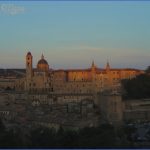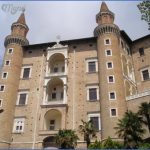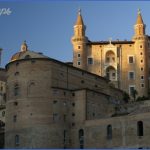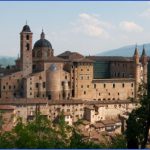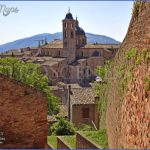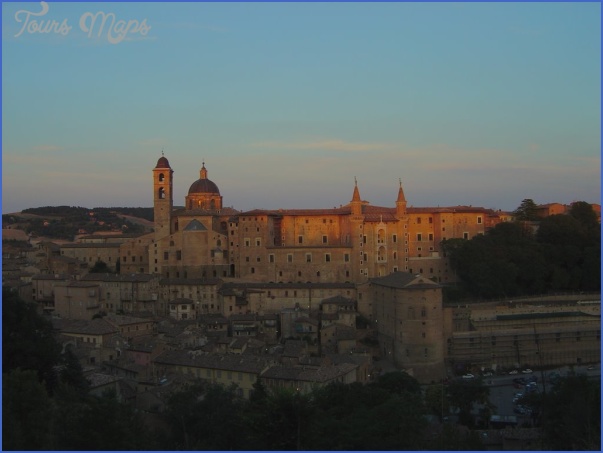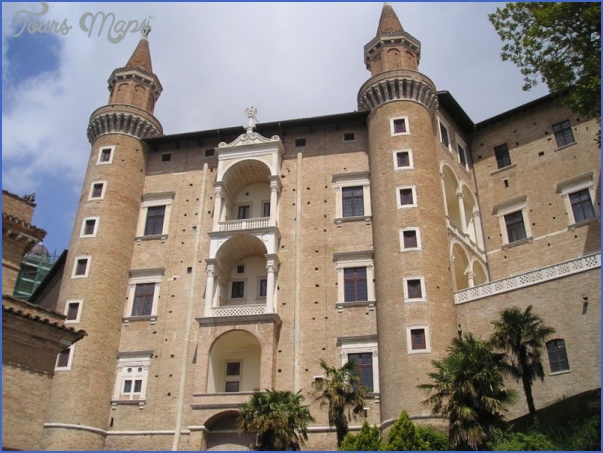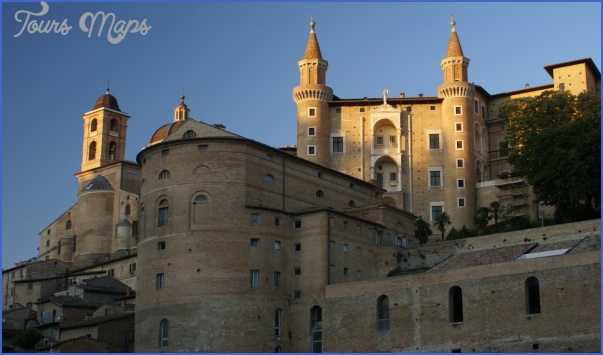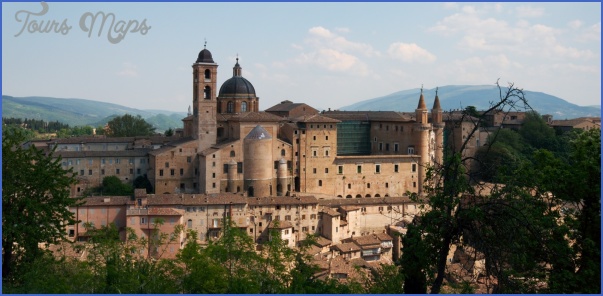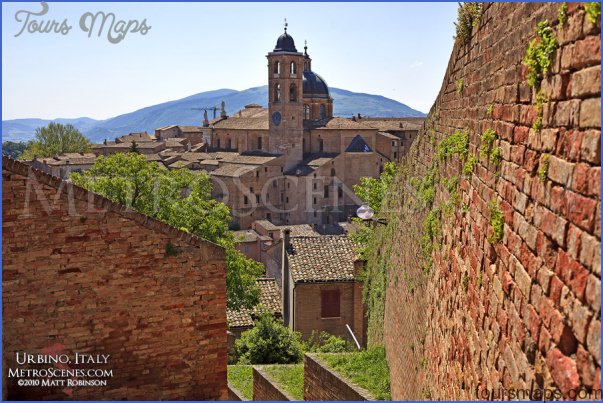LUCIANO LAURANA
In its stunning hillside setting the
Ducal Palace at Urbino is the perfect Renaissance house. It was built for Federico da Montefeltro, a war leader who employed architect Luciano Laurana to design the ultimate princely residence. Most of the famous Italian palaces of the Renaissance are symmetrical buildings with formal facades that front onto city streets or squares. Urbino is different, set on a rise, and with long, meandering walls that follow the lie of the land.
From the outside the palace looks big but plain. Reddish, clifflike walls built of locally made bricks rise high above the roofs of the surrounding town like the ramparts of a castle, except that the windows are too large for a defensible military structure. These rows of rectangular windows, some with dressed stone frames and some with plain brick surrounds, extend across the facade. Only a pair of slender round towers, topped with conical roofs, flanking stone classical arches containing balconies, signal that this building is something special as well as something huge.
Inside the gate things are quite different. At the heart of the palace is a typical feature of Renaissance design-a courtyard surrounded by a columned arcade. Here, perfectly proportioned round arches combine with sophisticated ornament to produce one of the most harmonious open-air spaces of the period.
The interiors display a similar mixture of qualities. Most rooms are plain, white-plastered, and adorned with exquisitely carved details. Others, such as the palace’s two chapels (one a conventional Christian place of worship and the other a pagan “Temple of the Muses) and Federico’s private studiolo (study), are intricately decorated. They are adorned with the best arts and crafts of the period-stunning wood inlay in the studiolo and marble and multicolored stucco in the Christian chapel.
FEDERICO DA MONTEFELTRO 1422-82
Born the illegitimate son of Guidantonio da Montefeltro, Lord of Urbino, Federico da Montefeltro’s birth was legitimized by Pope Martin V. As a young man Federico won fame as a military leader and, although involved in mercenary warfare, inspired loyalty from his men. In 1444 his half-brother Oddantonio was killed, and Federico became Duke of Urbino. He was suspected of playing a part in the murder, but this was never proved. As a war leader, Federico served the Dukes of Naples and Florence and several popes, although he had to step aside for a while after losing one eye in a tournament in 1450. From the 1460s onward he built his palace at Urbino, where he amassed an enormous library and patronized outstanding artists including Raphael.
His political skill attracted the admiration of many, including the writer Niccolo Machiavelli, whose book The Prince is based partly on him.
Visual tour
1 COLONNADED COURTYARD This arcaded inner courtyard, made in perfect Renaissance style, is in the middle of the building and provides access to a series of state rooms. Its architect, Luciano Laurana, was influenced by the work of Filippo Brunelleschi in Florence (see p.83). Laurana handled the classical elements the semicircular arches, the pilasters (flat columns) on the walls above, and the friezes bearing inscriptions with confidence and restraint.
The east side was designed by Maso di Bartolomeo
The second floor was added a century after the building was made
1 CAPITAL The courtyard columns are topped with ornate Corinthian capitals. Few Corinthian capitals have corner spirals that are so intricately carved. Combined with the short row of egg-and-dart molding, the effect is unusually rich. The design probably owes something to the way the Corinthian order is used on ancient Roman temples.
1 ARCHED BALCONIES Between the two slender corner towers is a pair of balconies, each framed in a semicircular arch. These balconies look out over the roofs of the town and over Federico’s domain, which included some 400 villages in the region.
1 WINDOW On the first floor, the windows are flanked with carved stone pilasters to highlight their importance. Although classical, these window surrounds play variations on the standard motifs only the upper two-thirds of the pilasters are fluted, for example.
1 CHAPEL OF REDEMPTION
This high, narrow room is famous for its surface decoration. Up to cornice level, the walls are lined with panels of marble. The barrel-vaulted ceiling continues the decorative scheme in multicolored stucco. The design is said to be the work of Venice’s leading architect Pietro Lombardo.
The main doorway leads to the entrance hall
1 DOORWAY Most of the rooms in the palace have plain white walls, but many have outstanding carved fireplaces and doorways with sculpted surrounds.
The best of these, alive with carved foliage, flowers, swags, and other designs, are the work of Italian sculptor Domenico Rosselli.
ON DESIGN
Intarsia is wooden or stone inlay used to make decorative patterns on furniture or on the walls or floors of buildings. The technique became popular in Italy in the Middle Ages, initially for abstract patterns. Around 1450 artists began to make pictorial designs, using different colored woods to create images of landscapes, still lifes, or architectural scenes. When Federico decided to decorate his most intimate room with intarsia, he employed a star artist, but no one knows who the Florentines Baccio Pontelli and Benedetto di Maiano are the main candidates. The artist produced images of a range of subjects, from a portrait of the Duke to still lifes, animals, and a landscape.
This small room is the most stunning space inside the palace. It served as a private study for the Duke and is lined with wooden paneling inlaid with a range of trompe l’oeil designs. The subjects indicate Federico’s interests and include astronomical instruments, books, arms, and armor.
Above the inlaid panels Federico hung a collection of portraits by the Flemish artist Joos van Wassenhove. The paintings show characters who interested or inspired the Duke philosophers such as Plato and Aristotle, writers from Homer to Dante, and religious figures, including St. Augustine and St. Jerome.
1 Intarsia panel in the studiolo
From the squirrel and basket of fruit to the landscape beyond, this panel is the work of a master.
Ducal Palace URBINO, ITALY Photo Gallery
Maybe You Like Them Too
- The Best Cities To Visit in The World
- World’s 10 Best Places To Visit
- Coolest Countries in the World to Visit
- Travel to Santorini, Greece
- Map of Barbados – Holiday in Barbados

